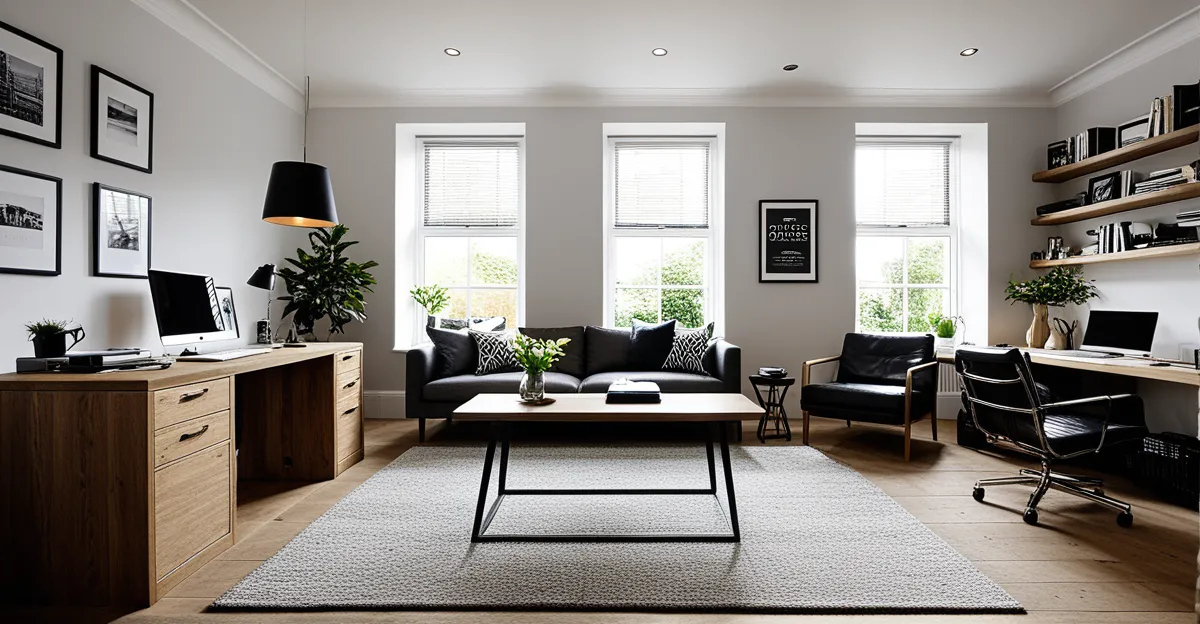Essential Steps to Transform Your UK Living Space into a Functional Office
Embarking on a home office conversion UK begins with a practical assessment of your available space. Choosing a quiet, well-lit corner away from household distractions enhances focus. UK homes often have unique space constraints, so selecting areas that maximize natural light and minimize noise is crucial.
When planning your remote work setup, it’s vital to consider UK home office advice regarding local housing and rental regulations. For instance, renters should verify landlord permissions before making structural changes. Understanding these legal boundaries helps avoid future complications while tailoring a workspace to your needs.
Additional reading : How Can Sustainable Living Improve Your UK Home Lifestyle?
Designing your workspace involves prioritizing comfort and productivity. Invest in ergonomic essentials to prevent strain, and arrange your furniture to facilitate efficient workflows. A clear desk layout combined with easy access to necessary tech and stationery supports sustained concentration. Incorporating storage solutions ensures clutter does not impede your focus.
Ultimately, transforming your living area into a dedicated office requires deliberate choices aligned with your lifestyle and compliance with UK-specific considerations. This approach ensures your workspace is both functional and legally sound, optimizing your remote work experience.
Also to read : How can UK homes maximize natural light for better living?
Smart Layout and Design Solutions for UK Homes
Maximising small spaces is critical when applying small home office ideas UK. In many UK homes, rooms tend to be compact, so an efficient workspace layout ensures functionality without sacrificing comfort. Selecting a corner or underutilised nook can create a dedicated area that feels distinct from living spaces.
To maximise small spaces, consider multi-functional furniture such as fold-away desks which can be stowed away when not in use, freeing valuable floor space. Storage solutions—like vertical shelving or under-desk drawers—help keep the area tidy without cluttering your workspace. These elements align with common UK housing constraints and offer practical flexibility.
Shared spaces often demand clever adaptations. For example, fitting a slim desk in a hallway or repurposing a dining table during work hours provides dual functionality. Lighting also matters: combining natural light with task lighting brightens confined areas and enhances productivity.
Innovative designs ensure your setup remains comfortable, efficient, and harmonised with the structure of your UK home. Embracing these small home office ideas UK makes remote work viable even in tight quarters.
Choosing Furniture and Tech for the Modern UK Home Office
Selecting the right home office furniture UK is essential for creating an ergonomic and efficient workspace. Prioritise adjustable desks and chairs that support good posture—key for long hours in a remote work setup. For example, sit-stand desks are increasingly popular in UK homes, allowing users to alternate between sitting and standing to reduce strain. Choose chairs with lumbar support and adjustable height to align with ergonomic standards.
When it comes to UK office tech, invest in dual monitors or high-resolution screens to enhance productivity. Reliable laptops or desktops with sufficient processing power are a must for smooth remote work operations. Don’t overlook peripherals like wireless keyboards, mice, and noise-cancelling headphones, which contribute to a distraction-free environment.
Smart technology integration also plays a role in modern UK offices. Voice assistants, smart lighting, and cable management solutions not only improve efficiency but help maintain an organised space. Incorporating these elements aligns with prevailing UK home office advice, ensuring your workspace supports both comfort and productivity while adapting to changing remote work needs.
Organisation and Storage Solutions to Keep Your Office Clutter-Free
Maintaining a tidy workspace is essential for productivity in any remote work setup. Effective home office organisation UK focuses on smart, space-saving storage solutions. Vertical shelving units are ideal for UK homes, optimising limited floor space while keeping documents and supplies accessible. Consider modular storage options that adapt to your evolving needs, preventing clutter accumulation over time.
Cable management is another crucial element of office storage solutions UK. Use clips, sleeves, or under-desk trays to organise wires neatly. This approach not only enhances the aesthetic but also reduces distractions and potential hazards, aligning with best UK home office advice.
To further declutter your workspace, implement regular routines: sort paperwork digitally or file essential documents immediately. Minimise desktop items to essentials only, promoting a focused environment. Efficient storage combined with disciplined organisation transforms compact spaces into practical, welcoming offices tailored to UK living conditions.
Setting Up an Ergonomic and Healthy Workspace
Creating an ergonomic home office UK is essential to maintain productivity and well-being during extended remote work. Poor posture and improper desk setups can lead to discomfort or long-term health issues. Start by selecting office furniture UK designed to promote natural alignment. Adjustable chairs with lumbar support and desks at the correct height prevent strain on your back and wrists.
Incorporate ergonomic accessories such as monitor stands or laptop risers to keep screens at eye level, which mitigates neck and shoulder pain. Good lighting is another key aspect. Use adjustable desk lamps or natural light to reduce eye strain, following prevalent UK home office advice. Additionally, placing your workspace near a window helps regulate circadian rhythms and boosts mood.
Regular movement breaks are vital. Simple stretches or standing intervals encourage circulation and reduce sedentary effects. In the UK, many suppliers offer ergonomic solutions tailored for limited spaces, ensuring your setup fits comfortably without clutter. Focusing on these elements within your remote work setup supports a sustainable, healthy workflow and long-term comfort while working from home.
Budget-Friendly Ways to Create an Office in Your UK Home
Creating a budget UK home office doesn’t mean sacrificing quality or functionality. Start by prioritising essential items like a comfortable chair and sturdy desk, which can often be found affordably through UK second-hand markets or online resale platforms. Many British sellers offer gently used home office furniture UK that meets ergonomic standards without the premium price.
For tech, look for refurbished or discounted laptops and peripherals that support your remote work setup. These cost-effective workspaces maintain performance while staying within budget. Incorporating DIY ideas, such as upcycling an old table with fresh paint or repurposing storage boxes, can further reduce costs while personalising your office.
UK home office advice often highlights the value of multi-purpose items to maximise space and savings. For instance, fold-away desks or stackable shelves combine practicality with affordability. Be sure to check local community sales or charity shops where quality furniture and tech suited for remote work can be picked up at reduced prices.
By following these strategies, you can build a productive, comfortable workspace that aligns with financial constraints, supporting a successful remote work setup in any UK home.
Essential Steps to Transform Your UK Living Space into a Functional Office
When planning a home office conversion UK, start by evaluating the available space realistically. Choose an area with minimal noise and good lighting to support concentration. A common question is: How do UK housing regulations affect home office setups? UK home office advice stresses that renters must obtain landlord consent before making structural changes, while homeowners should check local planning rules, ensuring compliance with safety and property standards.
Next, tailor your remote work setup for comfort and efficiency. This means investing in ergonomic furniture, positioning your desk to minimise glare, and arranging technology thoughtfully to reduce clutter and distractions. Comfort isn’t just about equipment—it also involves organising cables and supplies so essentials are within easy reach, boosting workflow.
Understanding these specific steps aligns with UK contexts and legal frameworks, helping you create a functional and compliant workspace. Prioritising productivity and regulation awareness at the outset prevents costly mistakes and supports a seamless transition from living space to a fully operational home office environment.









